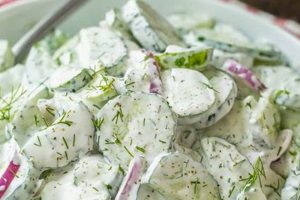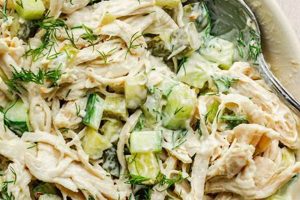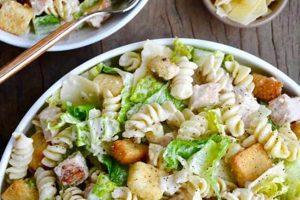A combination of cooked chicken, mayonnaise, dried cranberries, and walnuts creates a flavorful and textured salad. Variations can include different types of mayonnaise, the addition of celery, onion, or grapes, and seasonings such as salt, pepper, and poultry seasoning. This blend offers a balance of sweet, savory, and crunchy elements, making it a versatile dish.
This type of salad provides a good source of protein from the chicken and healthy fats from the walnuts. It can be enjoyed as a light meal, a sandwich filling, or served as part of a larger spread. The dish has likely evolved from traditional chicken salad recipes with the incorporation of cranberries and walnuts adding a more complex flavor profile and nutritional value, reflecting modern culinary trends.
Further exploration of this dish might include examining specific ingredient choices, variations in preparation methods, nutritional information, and serving suggestions. Different cultural adaptations and the evolution of chicken salad as a culinary staple could also be considered.
Tips for a Superior Chicken Salad
Optimizing ingredient selection and preparation techniques elevates this classic dish.
Tip 1: Chicken Selection: Using pre-cooked rotisserie chicken offers convenience. Alternatively, poaching or baking chicken breasts allows for greater control over flavor and texture. Avoid overcooking for optimal tenderness.
Tip 2: Mayonnaise Choice: Full-fat mayonnaise provides a richer flavor and creamier texture. Reduced-fat or plain Greek yogurt can be substituted for a lighter version. Experiment with flavored mayonnaises like chipotle or lemon for added complexity.
Tip 3: Cranberry Preparation: Dried cranberries can sometimes be overly dry. Briefly soaking them in warm water or juice plumps them up, improving their texture and distributing their sweetness throughout the salad.
Tip 4: Nut Enhancement: Toasting walnuts enhances their flavor and adds a desirable crunch. Consider other nuts like pecans or almonds for variation.
Tip 5: Balancing Flavors: A touch of acidity brightens the salad. A squeeze of lemon juice or a splash of apple cider vinegar achieves this balance. Finely diced red onion or celery adds a crisp, fresh element.
Tip 6: Seasoning: Freshly ground black pepper and salt are essential. A pinch of poultry seasoning or herbs like thyme or rosemary can complement the other flavors.
Tip 7: Chilling Time: Allowing the salad to chill for at least 30 minutes before serving allows the flavors to meld and enhances the overall experience.
Attention to these details ensures a flavorful and well-balanced salad, suitable for various occasions.
By understanding these key elements, one can create a chicken salad that is both delicious and satisfying.
1. Ingredients
Ingredient selection directly impacts the quality and character of chicken salad with cranberries and walnuts. Each component contributes specific flavors and textures, creating a complex interplay. For instance, the chicken provides the base, with its inherent savory notes. Choosing free-range or organic chicken can subtly enhance the overall flavor profile. Mayonnaise acts as the binder and adds a creamy richness. The type of mayonnaise, whether full-fat, low-fat, or a flavored variety, significantly alters the salad’s richness and tang. Cranberries introduce a contrasting tartness and sweetness. Their quality and moisture content influence the overall sweetness and chewiness of the salad. Walnuts contribute a crucial textural element with their satisfying crunch and subtle earthy flavor. Freshness and proper storage are paramount to prevent rancidity and maintain optimal taste.
Consider the impact of variations. Substituting pecans for walnuts introduces a buttery, slightly sweeter flavor profile. Adding celery offers a refreshing crispness, while red onion provides a pungent bite. These choices allow for customization based on individual preferences and dietary considerations. Using high-quality ingredients not only improves taste but also contributes to nutritional value. Fresh, wholesome components offer a greater concentration of vitamins, minerals, and antioxidants. This understanding enables informed decisions regarding flavor, texture, and nutritional content.
Optimal ingredient selection is fundamental to achieving a balanced and flavorful chicken salad. Understanding the role and impact of each ingredient allows for informed choices that cater to specific preferences and desired outcomes. Careful sourcing and proper storage practices are essential for maximizing flavor, texture, and nutritional benefits. This knowledge empowers individuals to create a truly exceptional and personalized chicken salad experience.
2. Proportions
Proportions play a crucial role in achieving a balanced and palatable chicken salad with cranberries and walnuts. The ratio of each ingredient influences the overall flavor profile, texture, and aesthetic appeal. Careful consideration of these ratios is essential for a successful culinary outcome.
- Chicken-to-Mayonnaise Ratio
The chicken-to-mayonnaise ratio determines the salad’s richness and moisture content. Too much mayonnaise results in a gloppy, overly rich salad, while too little can lead to a dry, crumbly texture. A balanced ratio ensures a creamy, cohesive mixture that allows the other ingredients to shine. A typical starting point is a 2:1 ratio of cooked chicken to mayonnaise, but this can be adjusted based on personal preference.
- Cranberry-to-Walnut Ratio
Balancing the sweetness of cranberries with the earthiness of walnuts is key. Too many cranberries can make the salad overly sweet, while an abundance of walnuts can overpower the other flavors and create a dense texture. A 1:1 ratio generally provides a pleasant balance, allowing both the tartness of the cranberries and the crunch of the walnuts to complement the chicken and mayonnaise.
- Inclusion of Other Ingredients
If incorporating additional ingredients like celery or onion, their proportions must be considered. These additions should enhance, not dominate, the primary flavors. A general guideline is to keep the combined volume of additional ingredients no more than half the volume of the chicken, ensuring they contribute texture and subtle flavor nuances without overwhelming the salad.
- Scaling the Recipe
Adjusting ingredient quantities while maintaining the established ratios is essential when scaling a recipe up or down. Doubling the recipe requires doubling all ingredients to preserve the intended balance of flavors and textures. This principle applies whether preparing a small batch for a single serving or a larger quantity for a gathering.
Understanding and controlling proportions allows for customization and ensures a consistently delicious and well-balanced chicken salad. By carefully considering the interplay of each ingredient, one can create a dish that caters to specific tastes and preferences, achieving a harmonious blend of flavors and textures.
3. Preparation Method
Preparation methods significantly influence the final quality and character of chicken salad with cranberries and walnuts. Different techniques affect the texture, flavor development, and overall appeal of the dish. Understanding these nuances allows for informed choices regarding the desired outcome.
- Chicken Preparation
The method used to cook the chicken impacts its texture and flavor contribution to the salad. Poaching results in tender, moist chicken, while baking or grilling can create slightly drier, more textured meat. Using pre-cooked rotisserie chicken offers convenience. The choice depends on the desired texture and flavor profile of the final salad.
- Ingredient Incorporation
The order and method of incorporating ingredients affect the final consistency and flavor distribution. Adding the cranberries and walnuts after the chicken and mayonnaise are combined prevents them from becoming overly saturated and losing their distinct textures. Gentle folding ensures even distribution without crushing the ingredients.
- Size and Shape of Ingredients
Uniformly dicing the chicken, and coarsely chopping the nuts creates a balanced textural experience. Larger chicken pieces provide more substantial bites, while finely chopped nuts distribute their flavor and crunch throughout the salad. The size of the cranberries also contributes to the overall mouthfeel.
- Chilling and Resting
Chilling the prepared salad allows the flavors to meld and enhances the overall experience. This resting period allows the ingredients to absorb the mayonnaise and seasonings, creating a more cohesive and flavorful blend. A minimum of 30 minutes is recommended, but longer chilling times can further enhance the flavor development.
Careful consideration of preparation methods elevates chicken salad with cranberries and walnuts from a simple dish to a culinary creation. Understanding the impact of each step, from chicken preparation to chilling, allows for precise control over the final product, ensuring a delicious and satisfying result. These seemingly small details contribute significantly to the overall quality and enjoyment of the dish.
4. Texture
Texture plays a crucial role in the overall enjoyment of chicken salad with cranberries and walnuts. The interplay of contrasting textures creates a dynamic sensory experience. The tenderness of the chicken provides a foundational softness, while the crisp crunch of the walnuts offers a stark contrast. Plump, chewy cranberries contribute another layer of textural complexity. This combination of soft, crunchy, and chewy elements keeps the palate engaged and prevents the salad from feeling monotonous. Consider a bite containing tender chicken, a crunchy walnut piece, and a slightly tart, chewy cranberry; the interplay of these textures elevates the eating experience. The creamy mayonnaise, while not a solid, contributes to the overall mouthfeel, coating the other ingredients and adding a smooth richness.
Manipulating ingredient size and preparation methods allows for further textural refinement. Dicing the chicken into larger pieces creates a more substantial bite, while shredding it results in a finer, more delicate texture. Similarly, coarsely chopping the walnuts provides larger, more pronounced crunchy pieces, whereas finely chopping them distributes the crunch more evenly throughout the salad. Soaking dried cranberries briefly before adding them to the salad plumps them, enhancing their chewiness. These seemingly minor adjustments can significantly impact the overall textural profile of the dish. For example, a salad with larger chicken pieces and coarsely chopped walnuts offers a more robust and rustic texture, while a salad with shredded chicken and finely chopped nuts provides a smoother, more refined experience. The choice depends on individual preferences and the desired outcome.
Achieving textural balance is essential for a successful chicken salad. The goal is not simply to include a variety of textures, but to ensure they complement each other harmoniously. An excess of any single texture, whether too much crunch from the walnuts or an overly smooth consistency from excessive mayonnaise, can detract from the overall enjoyment. A well-balanced texture profile enhances the interplay of flavors and elevates the dish from simple to sophisticated. This understanding allows for informed decisions during preparation, ensuring a delightful and satisfying culinary experience.
5. Flavor Balance
Flavor balance is paramount in a successful chicken salad incorporating cranberries and walnuts. This dish thrives on the interplay of contrasting yet complementary flavors. The inherent savory notes of the chicken provide a foundational taste, enhanced by the creamy richness of the mayonnaise. This richness, however, requires a counterpoint, which is where the cranberries and walnuts come into play. The tartness of the cranberries cuts through the richness of the mayonnaise, preventing the salad from becoming overly heavy. Simultaneously, the sweetness of the cranberries adds another layer of complexity, intertwining with the savory and creamy notes. Walnuts contribute an earthy depth and a subtle bitterness that further enhances the balance, preventing the sweetness of the cranberries from becoming dominant. This careful orchestration of flavorssavory, rich, tart, sweet, and earthycreates a dynamic and satisfying taste experience.
Consider the potential consequences of flavor imbalances. An overabundance of mayonnaise can lead to an overly rich and cloying salad, masking the other flavors. Too many cranberries can make the salad excessively sweet, while an insufficient quantity might not provide enough contrast to the richness of the mayonnaise. Similarly, neglecting the walnuts diminishes the earthy depth and textural complexity they offer. Real-life examples include a salad where the sweetness of the cranberries overwhelms the other flavors, or one where the lack of walnuts results in a one-dimensional taste experience. Understanding these potential pitfalls allows for careful ingredient selection and proportioning to achieve the desired flavor profile. For instance, using dried cranberries with a lower sugar content can mitigate excessive sweetness, while toasting the walnuts enhances their inherent earthiness and adds a subtle smoky note.
Achieving flavor balance is not merely about combining different tastes; it’s about creating a harmonious interplay where each element contributes to the overall profile without dominating the others. This understanding has significant practical implications, empowering individuals to adjust recipes to suit their preferences. Adding a squeeze of lemon juice can brighten the flavors and enhance the tartness, while incorporating a pinch of black pepper can add a subtle spice note. Recognizing the role and impact of each ingredient’s flavor allows for informed choices, transforming a simple chicken salad into a nuanced culinary creation.
6. Serving Suggestions
Serving suggestions transform a basic chicken salad recipe featuring cranberries and walnuts into a versatile culinary tool. These suggestions provide context and inspiration, demonstrating the adaptability of the salad across various applications. Serving suggestions bridge the gap between a prepared dish and its consumption, offering practical guidance on how best to enjoy it. A simple chicken salad can become a sandwich filling, a component of a composed salad, or an appetizer served with crackers or crudits. The choice of serving suggestion directly influences the overall dining experience, impacting presentation, portion size, and accompanying flavors. This understanding is crucial for maximizing the culinary potential of the recipe.
Practical examples illustrate this connection. Serving the chicken salad on croissants or in lettuce wraps elevates it beyond a basic lunch. Incorporating it into a larger composed salad with mixed greens, fruits, and a vinaigrette adds a refreshing element to a meal. Presenting the salad as a dip with an assortment of crackers or vegetables transforms it into a shareable appetizer suitable for gatherings. These variations demonstrate how serving suggestions broaden the recipe’s utility. Consider the difference between a simple scoop of chicken salad on a plate versus a carefully constructed croissant sandwich with crisp lettuce and juicy tomato slices. The serving suggestion elevates the perceived value and enjoyment of the same basic ingredient. Choosing complementary pairings enhances the overall dining experience. For instance, serving the chicken salad with a side of fruit salad complements the sweetness of the cranberries, while a serving of roasted vegetables provides a savory counterpoint.
Effective serving suggestions require an understanding of flavor profiles and textures. The sweet and savory notes of the chicken salad with cranberries and walnuts must harmonize with the chosen accompaniments. Textural contrasts further enhance the dining experience. Crunchy crackers or crisp lettuce provide a counterpoint to the creamy salad and crunchy nuts. This understanding enables informed choices that elevate the dish beyond its basic components. By viewing serving suggestions not as mere afterthoughts but as integral components of the recipe, one unlocks the full potential of chicken salad with cranberries and walnuts, transforming it from a simple dish into a versatile and satisfying culinary centerpiece.
Frequently Asked Questions
This section addresses common inquiries regarding chicken salad featuring cranberries and walnuts, offering concise and informative responses.
Question 1: What is the optimal storage duration for this type of chicken salad?
Refrigeration in an airtight container for up to four days is recommended. Beyond this timeframe, quality and safety may be compromised.
Question 2: Can frozen chicken be utilized in this recipe?
While frozen chicken can be used, thawing and cooking it thoroughly before incorporating it into the salad is essential. Texture may be slightly altered.
Question 3: Are there suitable alternatives to mayonnaise?
Plain Greek yogurt or a combination of yogurt and mayonnaise offer a lighter alternative while maintaining a creamy consistency. Flavor profiles will be subtly different.
Question 4: Can other nuts be substituted for walnuts?
Pecans, almonds, or cashews offer viable alternatives, each contributing a unique flavor profile and texture to the salad.
Question 5: How can one adjust the sweetness level?
The sweetness can be adjusted by using cranberries with varying sugar content or by adding a touch of honey or maple syrup for increased sweetness.
Question 6: What are some strategies for preventing the salad from becoming watery?
Ensuring the chicken is fully drained before incorporating it and using plump, rather than overly dry, cranberries helps maintain the desired consistency.
Understanding these aspects facilitates preparation and storage, ensuring a safe and enjoyable culinary experience.
This information assists in creating and enjoying chicken salad with cranberries and walnuts successfully.
Chicken Salad with Cranberries and Walnuts
Exploration of this dish reveals the interplay of carefully selected ingredients, precise proportions, and considered preparation methods. Flavor balance, textural contrast, and versatile serving options contribute to its appeal. From ingredient selection to serving, each step influences the final product. Understanding these elements allows for informed choices, ensuring a satisfying culinary experience.
Chicken salad with cranberries and walnuts represents more than a simple recipe; it embodies the potential for culinary creativity within established frameworks. Continued experimentation with ingredient variations and serving styles promises further evolution and enjoyment of this versatile dish.






